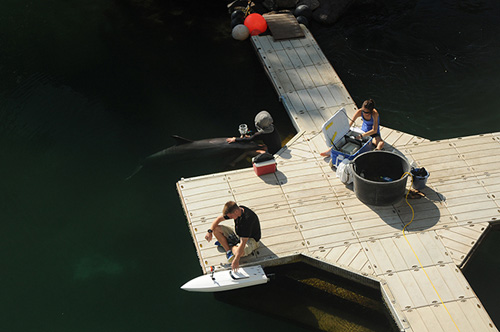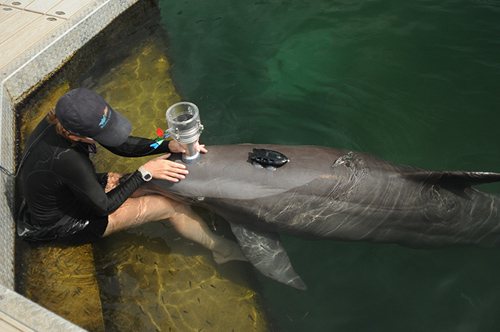For scientists studying marine mammals in the wild, data-logging tags are invaluable tools that allow them to observe animals’ movements and behaviors that are otherwise hidden beneath the waves much of the time. The tags, which temporarily attach to animals using suction, record sounds and gather information about animals’ pitch, speed, and depth. But what effect do the tags have on the animals?
Researchers from Woods Hole Oceanographic Institution (WHOI) and Texas A&M University-Corpus Christi (TAMUCC) are working with dolphins and their trainers at Dolphin Quest at The Kahala Hotel and Resort in Oahu to answer that question, among others.
“This research at Dolphin Quest gave us a unique opportunity to evaluate the metabolic cost of marine mammal suction cup data tags in a controlled environment,” said Michael Moore, director of the Marine Mammal Center at WHOI and a marine mammal veterinarian. “The dolphins work with the humans who care for them to generate data that are impossible to obtain from animals in the wild.”

MIT/WHOI Joint Program graduate student Julie van der Hoop (center, in blue), Courtney Yanovitch and Dallas Vandenberg, both of Dolphin Quest, prepare for the next round of testing. Dolphin Quest trainers taught the dolphins to follow a remote-controlled boat with a sensor on it that tracks each dolphin’s speed and duration of the session. The dolphins perform the task while wearing tags and also without. Image credit: Michael Moore, Woods Hole Oceanographic Institution
Marine animals have a low-drag body shape, close to the optimal hydrodynamic design. Attaching data tags to the animals could cause them to use more energy for ordinary activities, such as diving and feeding.
To test the drag created by the tags, Dolphin Quest trainers taught the dolphins to follow a remote-controlled boat with a sensor on it that tracks each dolphin’s speed and duration of the session. The dolphins perform the task with a tag and without.
The dolphins’ breaths are measured before they begin to determine each individual’s resting oxygen consumption and breathing rate. After swimming, each session ends with the dolphin greeting its trainer and giving a series of voluntary breath samples into a custom-made device that measures respiratory flow rates, oxygen and carbon dioxide levels of the expired gas.
“The data we collected will also provide baseline values for healthy dolphins, or what is normal,” said Dr. Andreas Fahlman, an assistant professor at TAMUCC, who developed the breath-measuring device along with Micah Brodsky of VMD Consulting. “This information can then be used for early detection of disease both in captive and wild animals.”

After swimming, each session ends with the dolphin greeting its trainer and giving a series of voluntary breath samples into a custom-made device that measures respiratory flow rates, oxygen and carbon dioxide levels of the expired gas. Image credit: Michael Moore, Woods Hole Oceanographic Institution
Results from this research will help scientists better interpret data in field studies with wild dolphins and other marine mammals, and could lead to the development of even better data tags in the future.
“If we understand that the instruments are not having a big impact on the animals, then let’s continue as we’re going,” said Julie van der Hoop, a graduate student in the MIT/WHOI Joint Program in Oceanography. “If we are seeing changes in behavior or energy use, then we need to think twice as we design these instruments and deploy them.”
In addition, Moore said the study could also help shed new light on the impacts of drag on marine mammals created from entanglements in fishing gear.
“These animals teach us about the impacts of humans on wild marine mammals, both in terms of minimizing the impact of research methods, but also understanding the real cost of factors such as entanglement in fishing gear and debris,” Moore said.
“The many challenges facing wild dolphins are so complex, it is imperative that we all come together to find solutions,” added Rae Stone, DVM, President and Partner of Dolphin Quest. “This groundbreaking work is a wonderful example of what can happen when esteemed scientists, engineers, physiologists, and animal behaviorists collaborate with these amazing animals.”
This work is part of a four-year study funded by the National Science Foundation through the National Oceanographic Partnership Program and the Office of Naval Research.
*Source: Woods Hole Oceanographic Institution
